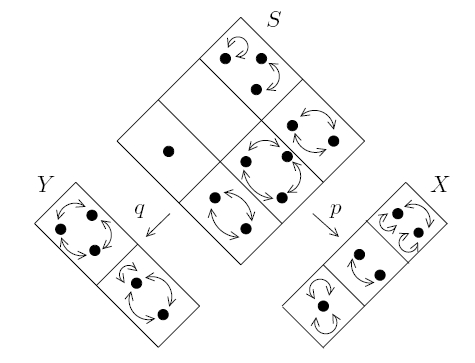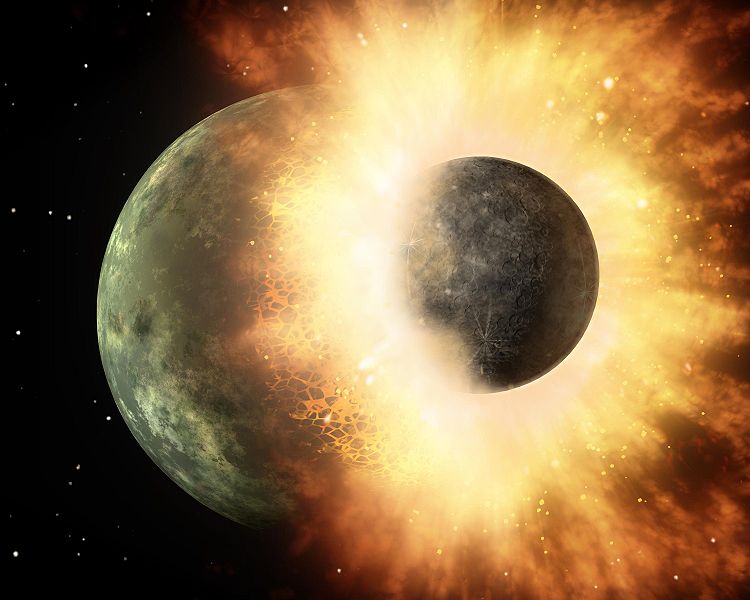




|
 
|

|
Mathematicians love to use groups to describe symmetries. Symmetries like to be symmetries of something, so groups like to act as symmetries of sets, vector spaces and other mathematical gadgets. Of all these choices, it's possible that mathematicians love vector spaces most of all - so there's an enormous subject called "group representation theory" devoted to studying how groups can act as symmetries of vector spaces.
Why vector spaces and not, say, sets? Maybe because mathematicians, despite whatever sophistication they may have obtained through years of schooling, are still most comfortable with numbers. We like to say "math is not just about numbers", which is true, but when nobody is looking many of us will secretly add, subtract, multiply or divide a few - and it's very satisfying.
A vector space is a bunch of vectors, and a vector can be seen as a list of numbers. A symmetry of a vector space is a linear transformation, and a linear transformation can be seen as a box full of numbers. So, group representation theory has the charm of combining beautiful sophisticated ideas with something mathematicians know how to handle: lots of numbers.
This is great, because it means when you get stuck and don't understand something in group representation theory, you can just grind away - adding, multiplying, subtracting and dividing - until you get a good idea.
But at a deeper level, it's a bit weird that of all the structures that groups can act on, we spend so much time studying their actions on vector spaces. The reason is obvious: it's amazingly useful. But what's a bit mysterious to me is why it's so amazingly useful!
One way to get a new perspective on this is "groupoidification". Groupoidification is a program for taking familiar math and redoing it with groupoids replacing vector spaces. Since a group can be seen as a special case of a groupoid, this puts a new spin on group representation theory. Instead of having groups in one corner and vector spaces in the other, now it's all about groupoids!
This sheds a whole new light on quantum mechanics. Early in the history of quantum mechanics, back when Heisenberg was still a grad student, he developed "matrix mechanics". In this idea, any physical process is described by a box of numbers. The number in the ith column and jth row says the amplitude for the system to hop from its ith state to its jth state.
Later it was realized that these matrices described linear operators. But with groupoidification, we replace these matrices by "spans of groupoids", which look like this:

These are even more primitive than boxes of numbers!
I've been thinking about this for a long time. Luckily, today I don't need to, because Alex Hoffnung, Christopher Walker and I just finished a big paper on groupoidification and put it on the arXiv:
1) John Baez, Alexander Hoffnung and Christopher Walker, Higher-dimensional algebra VII: groupoidification, available at arxiv:0908.4305.
You may remember the Tale of Groupoidification, which started in "week247", went on for several weeks, and then morphed into a series of videotaped lectures. You can find all that stuff here:
2) John Baez, The tale of groupoidification, available at http://math.ucr.edu/home/baez/groupoidification
Our new paper "HDA7" crystallizes some of this tale into theorems, but there's a lot more left. That's why Alex and I are writing "HDA8" on the groupoidification of Hecke algebras, and Christopher and I will - I hope - write "HDA9" on the groupoidification of quantum groups (or more precisely, Hall algebras).
But today I'm tired of writing about math, so this Week's Finds will mainly be about astrophysics, with a little bit about geophysics and a tiny bit about graphene. If you want to understand my cryptic comments about spans of groupoids and how matrix mechanics gets a new look after groupoidification, just read the introduction to HDA7.
In "week277" I said the star Betelgeuse may be shrinking rapidly - shrinking at a rate of 1000 kilometers per hour, according to one group of astrophysicists. This is exciting because Betelgeuse is a red supergiant, a big and shortlived type of star that's stopped burning hydrogen and is busy burning heavier elements. When it runs out of fuel, its core will collapse and then explode into a supernova, briefly becoming between 1 and 10 billion times as luminous as the Sun. From here it will look about as bright as the moon! Then its core will become a neutron star or black hole.
This could happen soon, or it could take a million years: no one knows.
Now two other teams have taken photos of Betelgeuse using the VLT - the "Very Large Telescope". And they've found something quite dramatic.
I showed you photos of the VLT back in "week226". It's actually a bunch of telescopes that can function as a single unit, built in the high Atacama Desert of northern Chile to minimize atmospheric effects - you know, that "twinkle twinkle little star" stuff.
The VLT also uses "adaptive optics" to counteract the effect of twinkling. For this, they shoot a laser beam into the sky:
3) Free from the atmosphere, European Space Observatory (ESO), http://www.eso.org/public/outreach/press-rel/pr-2007/pr-27-07.html
The beam excites sodium ions 100 kilometers up - ions created by tiny meteorites that are constantly hitting the atmosphere and vaporizing. Then the ions glow and create an "artificial star". The astronomers down below can watch the twinkling of this "star" and use the data to correct for the effect of atmospheric distortion.
Thanks to tricks like this, the VLT can take pictures with a resolution of 37 milliarcseconds - about the size of a tennis ball on the International Space Station, as seen from the ground!
This is how a team of astronomers led by Pierre Kervella discovered that Betelgeuse is spewing out a huge plume of gas that extends out 6 times the diameter of the star - in other words, the distance between the Sun and Neptune!
That's mighty impressive. Could it mean that Betelgeuse is about to go supernova? Nobody knows.
Another team has detected carbon monoxide coming out of Betelgeuse. This ties into another favoite subject of mine: dust!
In "week257" I talked about the dust spewed out by "asymptotic giant branch stars". Our Sun will become one of these someday - as will indeed most stars between 0.6 and 8 solar masses, in a late stage of their life. Right before they completely run out of fuel they can burn, these stars turn red, expand, and become unstable, periodically puffing out dust like smokestacks.
"Red supergiants" like Betelgeuse are different. Betelgeuse is about 20 times as massive as our Sun. Stars this big are rare, but they pump out a lot more dust. A well-studied example is α Herculis, known to some early astronomers as Ras Algethi. It's sort of small for a red supergiant, only 14 times the mass of our Sun. Some people classify it as a "bright giant" instead. It's part of a triple star system. It emits a stellar wind blowing outwards at about 10 kilometers per second, and it loses at least 6 × 1019 tons of mass each year. That's about 1% of the Earth's mass every year! Most of this stuff is hydrogen and helium, but about 0.5% of it condenses to form dust as it cools.
This dust includes organic compounds like polycyclic aromatic hydrocarbons, or PAHs. I said a lot about these in "week257". It also includes a lot of calcium-aluminum silicates and magnesium silicates: predecessors of some of the most common minerals here on Earth!
And indeed, that's how we got here: when a red supergiant finally goes supernova, all the dust surrounding it gets blown outwards by the shock wave, mixed in with really heavy elements formed by the supernova core collapse itself. This dust floats around... and eventually some of it forms clouds that can block starlight, cool down, collapse under their own gravity, and form solar systems like ours.
So, I like thinking about Betelgeuse as part of a rich galactic life cycle that also includes us.
For more details, see:
4) Sharpest views of star Betelgeuse reveal how supergiant stars lose mass, ScienceDaily, August 3, 2009, http://www.sciencedaily.com/releases/2009/07/090729074525.htm
5) Betelgeuse resolved, Astronomy Picture of the Day, August 5, 2009, http://apod.nasa.gov/apod/ap090805.html
6) Pierre Kervella et al, The close circumstellar environment of Betelgeuse. Adaptive optics spectro-imaging in the near-IR with VLT/NACO, Astronomy and Astrophysics, 2009. Also available as arXiv:0907.1843.
7) Keiichi Ohnaka et al, Spatially resolving the inhomogeneous structure of the dynamical atmosphere of Betelgeuse with VLTI/AMBER, Astronomy and Astrophysics, 2009. Also available as arXiv:0906.4792.
8) Jacco Th. van Loon, The effects of red supergiant mass loss on supernova ejecta and the circumburst medium, in Hot and Cool: Bridging Gaps in Massive Star Evolution, Pasadena, November 2008. Also available as arXiv:0906.4855.
Speaking of dust, there's a great blog entry by Stefan Scherer about dust in a planetary system 95 light years away - silica dust that seems to have been created by a high-speed collision of planets only a few thousand years ago!

9) Stefan Scherer, News from other worlds, Backreaction, http://backreaction.blogspot.com/2009/08/news-from-other-worlds.html
10) C. M. Lisse et al., Abundant circumstellar silica dust and SiO gas created by a giant hypervelocity collision in the ~12 Myr HD172555 System, Astrophys. J. 701 (2009), 2019-2032. Also available as arXiv:0906.2536.
If you have some pent-up aggression and feel the need for catharsis, try watching an animated movie of this collision:
11) The Bad Astronomer, When worlds collide, http://blogs.discovermagazine.com/badastronomy/2009/08/10/when-worlds-collide/
It makes the collision that seems to have created our Moon look pretty tame by comparison.

By the way, you can read my tale of that collision, and some other dramatic developments in the Earth's history, here:
12) John Baez, The Earth - for physicists, PhysicsWorld, July 31, 2009. Available at http://physicsworld.com/cws/article/print/39959 or http://math.ucr.edu/home/baez/earth.html
Moving from big splats to little flashes, here's an interesting item pointed out by Daniel Rocha. I described one way to make graphene in "week277" - by taking graphite crystals and carefully peeling off layers with the help of scotch tape. There are other methods but they're expensive and annoying. Now they've found a better way: take a sheet of "paper" made of graphite oxide and zap it with the flash of an ordinary camera!
13) Northwestern researchers create graphene in a flash, DailyTech, http://www.dailytech.com/Northwestern+Researchers+Create+Graphene+in+a+Flash/article15976.htm
Okay, that's all for this week. I'm still passionately interested in math, and I've been learning so much beautiful stuff lately that I almost despair of explaining it all. But I've been spending so much time writing papers that I need a little break!
Addenda: For more discussion visit the n-Category Café.
Abstract work, if one wishes to do it well, must be allowed to destroy one's humanity; one raises a monument which is at the same time a tomb, in which, voluntarily, one slowly inters oneself. - Bertrand Russell
(I hope it ain't true.)
© 2009 John Baez
baez@math.removethis.ucr.andthis.edu

|
 
|

|